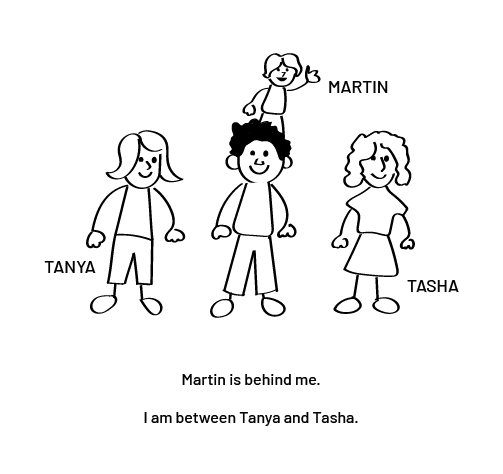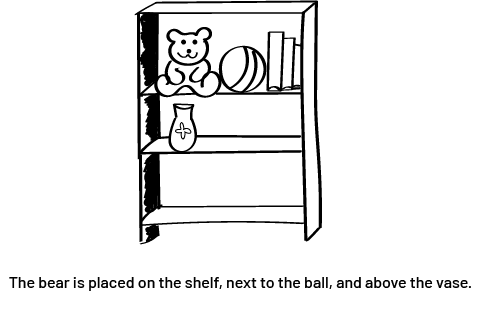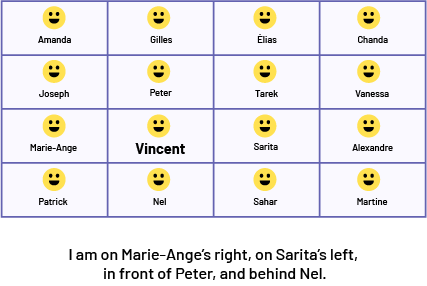E1.4 Describe the relative locations of objects or people, using positional language.
Skill: Describing Relative Location
In the Primary Division, children constantly observe their environment and establish points of reference in order to situate themselves in the space around them. They first situate people or objects in relation to themselves and then situate themselves in relation to other people or objects.
Example 1

To describe the location of an object, the student looks around the object to find benchmarks.
Example 2
 image Here are several shelves. On the first shelf, there is an empty space, a ball and books. On the second shelf there is only a vase under the empty space. Place the bear on the shelf following this order: « The bear is placed on the shelf, next to the ball, and above the vase. »
image Here are several shelves. On the first shelf, there is an empty space, a ball and books. On the second shelf there is only a vase under the empty space. Place the bear on the shelf following this order: « The bear is placed on the shelf, next to the ball, and above the vase. »
To locate an object, the child first selects or identifies an object as a benchmark. Then, they combine several benchmarks to identify or locate objects according to a tracking system. For example, the child can recognize that the red lines in the gym are the boundaries of their classroom. In Grade 1, they can locate a student in the classroom in relation to other students.
Example 3
 image A grid of 4 columns and 4 rows. In each box there is a smiley face and a first name. From the top going from left to right: Amanda, Gilles, Elias, Chanda, Joseph, Peter, Tarek, Vanessa, Marie-Ange, Vincent, Sarita, Alexandre, Patrick. Nel, Sahar, Martine. A label below the grid: "I am to the right of Marie-Ange, to the left of Sarita, in front of Peter and behind Nel."
image A grid of 4 columns and 4 rows. In each box there is a smiley face and a first name. From the top going from left to right: Amanda, Gilles, Elias, Chanda, Joseph, Peter, Tarek, Vanessa, Marie-Ange, Vincent, Sarita, Alexandre, Patrick. Nel, Sahar, Martine. A label below the grid: "I am to the right of Marie-Ange, to the left of Sarita, in front of Peter and behind Nel."
Source: translated from Guide d’enseignement efficace des mathématiques de la 1re à la 3e année, Géométrie et sens de l'espace, p. 56-58.
Skill: Using Vocabulary Associated With the Location
Terms usually used to describe the location of one object in relation to another are: on, under, in front of, behind, next to, near, far from, in, out, up, down, in, to the left of, to the right of, above, below, between, immediately to the right of, immediately to the left of.
Example
 image There is a swing in the middle of the page. Here is Anab, a ball and a sandbox. Place the objects by following the order. the first order is: « The sandbox is next to the swing. » The second order is: « Anab is far from the sandbox. » The third order is: « The ball is under the swing. »
image There is a swing in the middle of the page. Here is Anab, a ball and a sandbox. Place the objects by following the order. the first order is: « The sandbox is next to the swing. » The second order is: « Anab is far from the sandbox. » The third order is: « The ball is under the swing. »
Source: translated from Guide d’enseignement efficace des mathématiques de la 1re à la 3e année, Géométrie et sens de l'espace, p. 56-57.
